
The Forest of Dean is a geographical, historical and cultural region in the western part of the county of Gloucestershire, England. It forms a roughly triangular plateau bounded by the River Wye to the west and northwest, Herefordshire to the north, the River Severn to the south, and the City of Gloucester to the east.

Forest of Dean is a local government district in west Gloucestershire, England, named after the Forest of Dean. Its council is based in Coleford. Other towns and villages in the district include Blakeney, Cinderford, Drybrook, English Bicknor, Huntley, Littledean, Longhope, Lydbrook, Lydney, Mitcheldean, Newnham and Newent.

The region now known as Gloucestershire was originally inhabited by Brythonic peoples in the Iron Age and Roman periods. After the Romans left Britain in the early 5th century, the Brythons re-established control but the territorial divisions for the post-Roman period are uncertain. The city of Caerloyw was one centre and Cirencester may have continued as a tribal centre as well. The only reliably attested kingdom is the minor south-east Wales kingdom of Ergyng, which may have included a portion of the area. In the final quarter of the 6th century, the Saxons of Wessex began to establish control over the area.
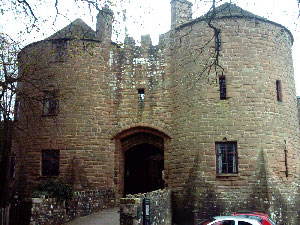
St Briavels, is a medium-sized village and civil parish in the Royal Forest of Dean in west Gloucestershire, England; close to the England-Wales border, and 5 miles (8 km) south of Coleford. It stands almost 800 feet (240 m) above sea level on the edge of a limestone plateau above the valley of the River Wye, above an ancient meander of the river. To the west, Cinder Hill drops off sharply into the valley. It is sheltered behind the crumbling walls of the 12th century St Briavels Castle.
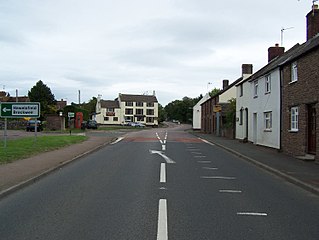
Alvington is a village and civil parish in the Forest of Dean in Gloucestershire, England, situated on the A48 road, six miles north-east of Chepstow in Wales. The parish had a total population of 506 at the 2011 census.

Awre is a village, civil parish and electoral ward in the Forest of Dean District of Gloucestershire, England, near the River Severn.
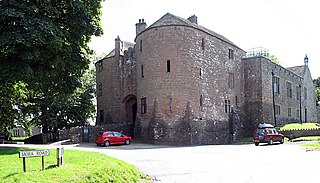
St Briavels Castle is a moated Norman castle at St Briavels in the English county of Gloucestershire. The castle is noted for its huge Edwardian gatehouse that guards the entrance.

Drybrook is a village and civil parish in the Forest of Dean in west Gloucestershire, England.

Littledean is a village in the Forest of Dean, west Gloucestershire, England. The village has a long history and formerly had the status of a town. Littledean Hall was originally a Saxon hall, although it has been rebuilt and the current house dates back to 1612. The remains of a Roman temple are situated in the grounds. Neither the hall or Roman remains are open to the public.

Clearwell is a village and former ancient manor in the Forest of Dean, West Gloucestershire, England. A recent survey indicated that the population of Clearwell is approximately 350.
Alexander de Bicknor was an official in the Plantagenet kingdom under Edward I of England, Edward II of England, and Edward III of England. Best known to history as the Archbishop of Dublin from 1317 until his death in 1349, his career involved extensive diplomatic missions for the King and the holding of numerous civil and ecclesiastical offices in Ireland, including Lord Treasurer of Ireland (1307–1309) and Lord Chancellor of Ireland.

Staunton is a village and civil parish in the Forest of Dean in west Gloucestershire, England, close to the border with Wales.
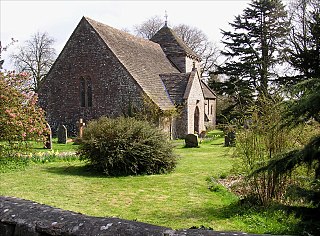
Hewelsfield is a village in Hewelsfield and Brockweir civil parish, in the Forest of Dean district of Gloucestershire, England.
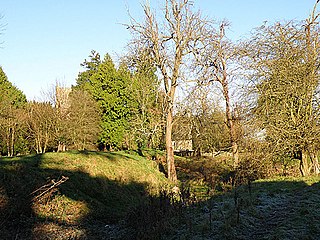
English Bicknor Castle was a castle in the village of English Bicknor in Gloucestershire, England.

Bledisloe was an ancient hundred of Gloucestershire, England. It comprised the ancient parishes of

St Briavels was an ancient hundred of Gloucestershire, England. It comprised the extra-parochial area of the Forest of Dean, and the ancient parishes of

Hewelsfield and Brockweir is a civil parish in Forest of Dean District, Gloucestershire. The parish was called Hewelsfield until 1994. It contains two distinct villages, Hewelsfield and Brockweir, with scattered settlement on Hewelsfield common.

Cantref Coch was an area associated with the ancient kingdoms of Ergyng, Gwent and the later Kingdom of Glamorgan. Cantref Coch is linked with the modern Forest of Dean and is defined as the land between the River Severn and the River Wye, with the Severn Sea as its southern border although its northern border is less certain. It is one of the few medieval cantrefi named by Welsh writers that is not within the modern nation of Wales.
















